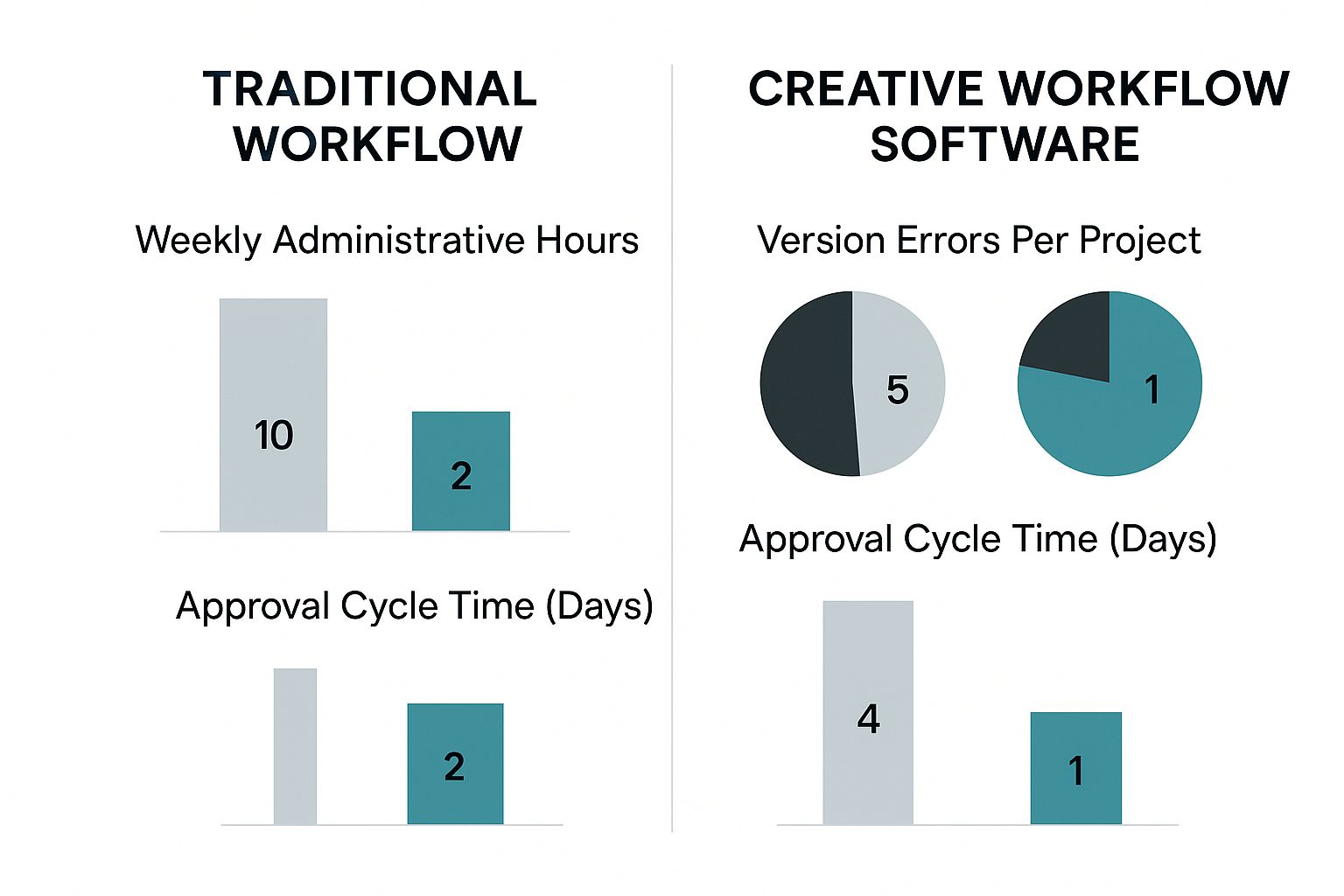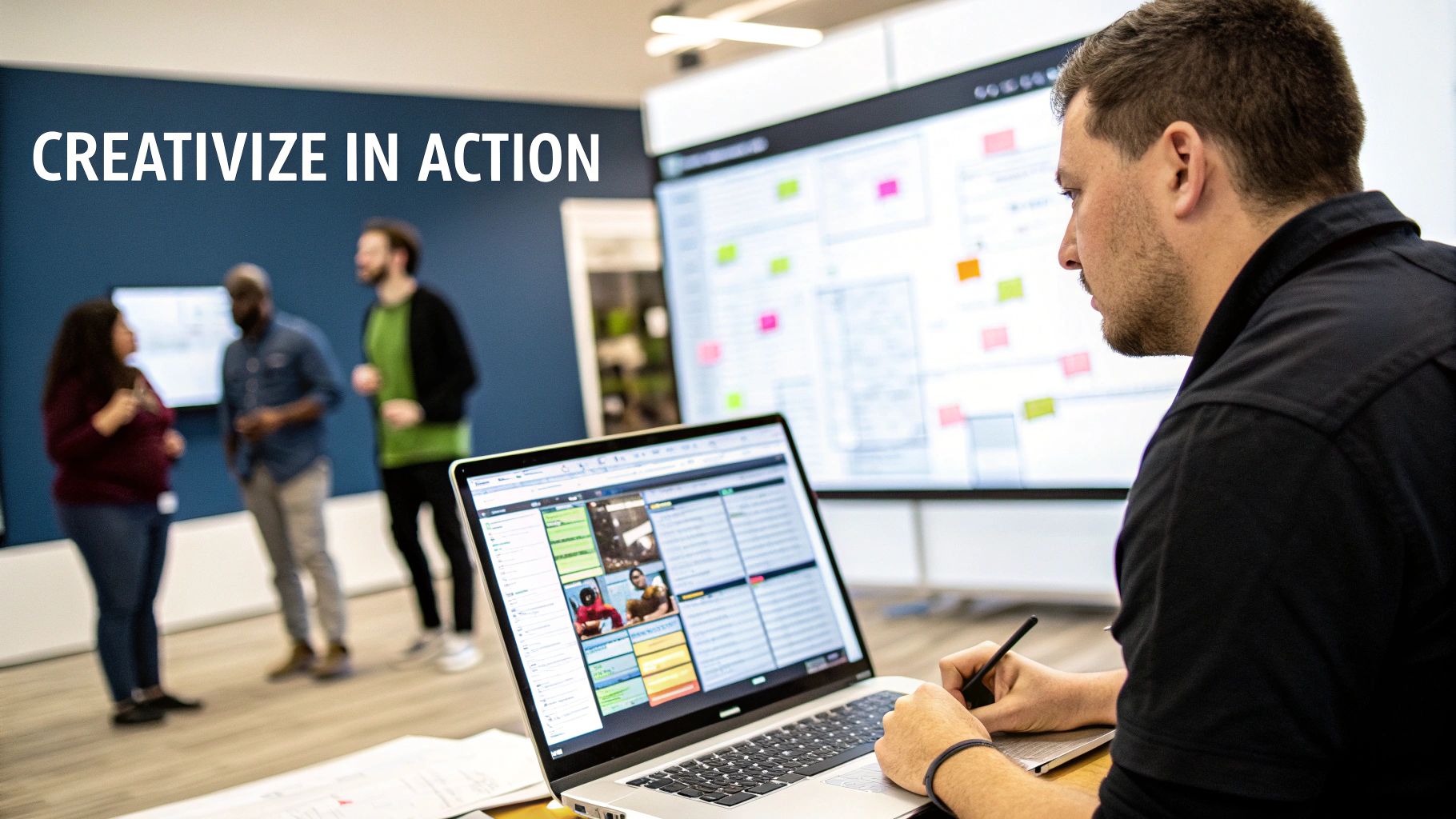Are you constantly staring down missed deadlines? Wrestling with version control nightmares? Trying to untangle who said what in a dozen different communication channels? This state of creative chaos is the unfortunate reality for way too many teams just trying to do brilliant work.
That’s where creative workflow management software comes in. It’s a specialized kind of tool designed to bring order, clarity, and a serious dose of efficiency to the entire creative process.
From Creative Chaos to Effortless Flow

Imagine trying to build a complex piece of furniture, but your tools are scattered all over the house. The screwdriver is in the kitchen, the nails are out in the garage, and the instructions are buried under a pile of mail on the dining room table. It’s a mess.
This is exactly how many creative teams operate, juggling a random mix of emails, chat apps, and cloud storage to push projects forward. The result? Wasted time, endless frustration, and a much higher chance of making costly mistakes.
This is the problem that creative workflow management software is built to solve. It’s not just another project management tool; think of it as a dedicated digital command center built specifically for the unique, often non-linear way creatives get things done. Traditional project management software often falls flat because it treats a creative task like any other item on a checklist, completely ignoring the messy, iterative, and collaborative soul of design, writing, and production.
The Power of a Centralized Hub
A dedicated platform pulls every single piece of a project into one place, creating a single source of truth for your entire team. No more digging through ancient email threads for the latest feedback. No more guessing which file in the shared drive is the actual final version.
Instead, everything you need is organized and right where it should be:
- Project Briefs: Clear goals and requirements are front and center for everyone from the get-go.
- Digital Assets: All files, from the first messy mockups to the final polished deliverables, are stored and versioned automatically.
- Communication: Team chats and stakeholder feedback are tied directly to the creative asset being discussed.
- Approvals: Formal sign-offs are tracked, creating a clear audit trail and stopping bottlenecks before they start.
By bringing some much-needed structure to the creative process, these platforms empower teams to shift from constantly putting out fires to proactively planning their work. This is the fundamental change that allows creative output to scale without sacrificing an ounce of quality.
Ultimately, bringing a creative workflow management software solution into your world is about fundamentally changing how your team operates. It clears away the administrative clutter that so often suffocates creativity, allowing your designers, writers, and artists to get back to focusing on what they do best. By understanding the core of a structured creative project workflow, you can set the stage for a more efficient, collaborative, and genuinely impactful creative process.
So, What Exactly Is Creative Workflow Management Software?
Think of it as a digital studio manager. Or maybe the head chef in a busy kitchen during the dinner rush.
It’s the central nervous system for your creative projects, pulling every moving part—from the first random idea to the final client sign-off—into one organized, sane space. This isn't just another to-do list app. It’s a command center built for the beautiful chaos of creative work.
The whole point is to create a single source of truth. No more digging through a thousand emails for that one piece of feedback. No more guessing which "final_final_v3.psd" file is the actual final one. Everything lives in one place. That simple change is a game-changer.
This Isn't Your Standard Project Tool
Most generic project management tools see tasks as widgets on an assembly line. They're linear, predictable, and frankly, boring. But you and I know creativity just doesn't work that way. It’s a messy, fluid process that rarely follows a straight line.
Creative workflow software gets this. It's designed for that non-linear dance. It understands that a design might need to jump back to the concept phase after some tough feedback, or that you'll have three different video edits happening at the same time.
A generic tool might tell you a task is "in progress." A creative workflow platform shows you what is in progress. You can see the actual design, read the comments right on the image, and watch it evolve from one version to the next.
That distinction is everything. These platforms are built around the work itself, not just a checklist of tasks. They give you the context you need to make smart creative calls without wasting time.
Why Everyone's Talking About These Tools Now
Let's be real: the pressure on creative teams today is intense. You're expected to crank out more amazing content, faster than ever, and often with a team scattered all over the map. This constant demand for speed and quality is exactly why these specialized tools are no longer a "nice-to-have."
The numbers tell the same story. The creative software market is expected to jump from $10.02 billion in 2025 to almost $14.48 billion by 2032. A huge chunk of that growth is coming from cloud-based platforms that let teams collaborate in real-time, no matter where they are. You can dig into more of the data on the growth of the creative software market for yourself.
This trend points to a big shift. Agencies and in-house teams just can't afford the old, clunky way of doing things anymore. Trying to stitch together a workflow with a patchwork of different apps is a recipe for missed deadlines, confused feedback, and work that has to be done over and over.
A dedicated platform is built to fix the classic headaches:
- Scattered Communication: Forget trying to piece together a conversation from email, Slack, and text. All discussions happen right on the creative files, where they make sense.
- Version Control Nightmares: It automatically tracks versions, so everyone is always looking at the latest draft. No more confusion.
- Approval Gridlock: You can build custom approval paths to make sure the right people sign off at the right time, keeping the project flowing smoothly.
At the end of the day, creative workflow management software provides the structure that creativity needs to thrive. It gets rid of all the administrative friction, so your team can focus on what they were hired to do: create incredible work that gets results. It's the invisible engine that powers modern creative operations.
The Core Features That Power Creative Teams
Okay, so you get it. A dedicated platform can tame the creative chaos. But what's actually inside the box? Let's pop the hood and look at the core features that make creative workflow management software work so well. These aren't just flashy add-ons; they're specific solutions built to fix the most common headaches that bring creative teams to a grinding halt.
Think of it like this: you wouldn't use a regular wrench on a specialty bolt. Yet, that's what so many teams do every day, forcing generic project management tools to handle highly specific creative tasks. The right features make all the difference, turning a clunky, disjointed process into something smooth and connected.
Centralized Digital Asset Management
Every creative project lives and dies by its files. And there are always so many of them. A digital asset management (DAM) system is the beating heart of these platforms, acting as a smart, secure library for every single image, video, and design file your team touches. It’s a massive upgrade from a simple cloud folder.
Instead of digging through a messy shared drive for "logo_final_v4_approved.png," a DAM organizes everything with tags, metadata, and project folders. Anyone on the team can find the exact asset they need in seconds. This creates a single source of truth and kills the risk of someone accidentally using an old or unapproved file.
Automated Version Control
One of the biggest project killers? Confusion over which version of a file is the real one. Automated version control puts an end to that nightmare for good.
Every time a team member uploads a new draft, the software neatly stacks it as a new version, creating a clear, visual timeline of the file's journey. Stakeholders can literally compare v1 and v4 side-by-side to see how feedback was handled. No more guesswork, no more lost edits. This one feature alone prevents costly mistakes and saves hours of detective work.
This visual timeline is a game-changer. It shifts the conversation from, "Did you see my email with the new file?" to, "Let's pull up the last two versions and compare them right here." It’s a tiny change in process that has a huge impact on clarity.
Just look at the massive gains teams see when they switch from old-school methods to a real, integrated solution.

The numbers don't lie. Teams using this kind of software cut their admin work by 80%, practically eliminate version mistakes, and slash approval times by a whopping 75%.
Customizable Approval Workflows
Let's be honest, waiting for approvals is where projects go to die. Customizable approval workflows turn that passive waiting game into an active, automated process.
You can build out multi-step approval paths that automatically ping the right person at the right time. For example, a design can go to the creative director first, and once they hit 'approve,' the system instantly sends it over to the client for the final sign-off.
This automation keeps the project moving without anyone having to chase people down. Everybody knows exactly who needs to act next, which builds accountability and dramatically speeds up the whole timeline.
Real-Time Collaboration And Proofing
This is where the magic really happens. Instead of getting a vague email that says "make the logo bigger," teams can use visual proofing and annotation tools to give crystal-clear feedback.
Stakeholders can click directly on an image, video, or PDF and drop a comment right on the spot. This kind of contextual feedback gets rid of all the ambiguity and gives the creative team a clear, actionable to-do list. The designer sees every single requested change marked up directly on their work.
This transforms the entire review process from a frustrating back-and-forth into a genuinely productive conversation. It’s one of the most powerful ways to improve the quality of feedback and the final output. If you really want to dial in this part of your process, checking out different design feedback tools can give you even more ideas for making collaboration click.
Before we move on, let's just quickly compare how these tasks get done the old way versus inside a dedicated platform. The difference is night and day.
Traditional Workflow vs Integrated Software
| Task | Traditional Method (Email, Spreadsheets, Chat) | Creative Workflow Management Software |
|---|---|---|
| Asset Sharing | Attaching large files to emails or sharing messy cloud links. | A centralized DAM where everyone accesses the latest approved versions. |
| Version Tracking | Confusing file names like final_v2_APPROVED_use-this-one.psd. |
Automated version history with side-by-side comparison. |
| Getting Feedback | Vague, easily missed comments buried in long email threads. | Pinpoint annotations and comments placed directly on the creative asset. |
| Securing Approvals | Manually chasing stakeholders via email and chat for sign-off. | Automated, multi-stage approval flows that notify people automatically. |
| Task Management | Juggling project status in spreadsheets and separate to-do list apps. | An all-in-one view of tasks, deadlines, and project progress. |
It's clear that patching together a bunch of separate tools just can't compete with a system designed from the ground up for creative work.
Ultimately, all these features work together to create a single, cohesive space where creativity can actually flow. By solving the administrative and communication nightmares that bog down most teams, this software frees up designers, writers, and producers to focus on what they do best: creating amazing work.
What You Gain From a Smoother Creative Operation

Bringing a new tool into the mix can feel like a huge step, but the payoff from a solid creative workflow platform makes it worth it. We’re talking about more than just getting organized—these tools fundamentally change how your team works, unlocking efficiency and creative power that you can see on the bottom line.
Right off the bat, you'll notice a massive drop in administrative busywork. Just think about all the hours your team loses hunting for files, trying to make sense of vague email feedback, or chasing down stakeholders for an approval. A good platform automates the tedious stuff, giving your creatives their most precious resource back: time to create.
Speed Up Your Entire Creative Timeline
When your process clicks, everything just moves faster. Projects that used to drag on for weeks can suddenly get turned around in days. It's not magic. It’s simply what happens when you remove all the little roadblocks that slow creativity to a crawl.
For instance, automated approval workflows mean a design concept doesn't just sit in someone's inbox for three days. The right person gets pinged instantly, and the moment they give the thumbs-up, the project is already moving on to the next stage. That momentum builds on itself, collapsing the entire project timeline.
Creative management platforms are especially good at this. Take the case of a delivery startup that used one to pump out 5,000 unique image and video ads for 400 different locations. They did it in just two hours. That’s a task that would have easily eaten up a full five-day workweek the old-fashioned way. It just goes to show the incredible speed and scale these tools unlock.
Raise the Bar on Creative Quality and Consistency
Speed is great, but not if it comes at the cost of quality. The good news is, a smoother workflow actually leads to better, more consistent work. When feedback is clear, centralized, and attached directly to the creative, designers and writers can nail revisions without any of the usual guesswork.
With a single source of truth for assets, brand guidelines, and feedback, every single piece of content stays on-brand and perfectly aligned with the project's goals. That kind of consistency builds a much stronger, more recognizable brand.
This kind of structured environment also cuts down on painful, costly rework. By catching a misunderstanding early in a visual proofing stage, you stop the team from sinking hours into a concept that was based on a misinterpreted email. It keeps projects on budget and, just as importantly, keeps your team happy by removing a huge source of frustration. Getting the fundamentals of creative operations management right is what makes this level of harmony possible.
Connect the Dots Between Daily Wins and Business Goals
At the end of the day, these operational improvements deliver real business advantages. Faster project delivery means a quicker time-to-market for campaigns, products, and features, giving you a serious leg up on the competition.
The efficiency gains also mean a much higher return on investment (ROI) from your creative team. When they can produce more top-tier work in the same amount of time, the value they generate goes through the roof. You can scale up your content without having to scale up your headcount, turning your creative department into a powerful engine for growth. Teams are even starting to leverage AI to launch ads, pushing efficiency even further. By linking daily tasks directly to bigger business objectives, creative workflow software proves it’s not just a nice-to-have—it’s an essential investment.
How to Choose the Right Software for Your Team
Picking the right creative workflow software can feel like a huge, high-stakes decision. It doesn’t have to be. The secret is to forget about product pages and demos for a minute and start by looking inward at your own team.
Think of it like getting a custom suit. You wouldn't just grab one off the rack and cross your fingers, right? You'd get measured first. It's the exact same idea here.
Start by mapping out how your team actually works, from the first spark of an idea to the final deliverable. Get specific about the moments where things get messy or grind to a halt. Is it the chaotic feedback loop? The endless scavenger hunt for the right asset? The approval bottlenecks that leave projects collecting dust for days?
Once you have your biggest pain points identified, you've got a crystal-clear shopping list of problems that need solving.
Key Criteria for Your Evaluation
With your team's needs clearly defined, you can start looking at your options through a much sharper lens. Look past the flashy features and zero in on the core functions that will actually make a difference in your day-to-day.
Your checklist should include these non-negotiables:
- Scalability: Can this platform grow with you? A tool that’s perfect for a team of five should have a clear, painless path to supporting a team of fifty without breaking your budget.
- User Interface (UI): Is it intuitive? Is it clean? Creatives are visual people, full stop. If the software is clunky or just plain ugly, your team won't use it, no matter how powerful it is.
- Integration Capabilities: Does it play nice with the tools your team already lives in? Smooth connections to essentials like Adobe Creative Cloud, Figma, and Slack are a must for keeping things flowing.
- Customer Support: When you hit a snag—and you will—how good is their support? Look for companies that offer solid training, clear help docs, and actual humans you can talk to.
The Power of Team Involvement
This is the most important step, and it’s the one most managers skip. The best software on earth is totally useless if the people meant to use it don't buy in. You have to involve your creative team in the process from the very beginning.
Getting your team's input isn't just about making them feel heard—it's about making a smarter decision. Your designers, writers, and video editors are in the trenches every day; they know better than anyone what will actually make their jobs easier.
Set up demos with your top two or three contenders and make sure your team is there to grill them with questions. Better yet, sign up for free trials. Give them a small, real-world project to run through each platform. Let them get their hands dirty.
When you empower your team to be part of the decision, you create a sense of ownership. They become champions for the change, not resistors. This approach ensures you pick a tool that truly fits your team’s size, budget, and creative goals. For a deeper dive, our guide on selecting the best project management software for creatives offers even more valuable insights. Making the choice together is the best way to guarantee a smooth rollout and a more efficient future.
Putting Theory Into Practice with Creativize

It's one thing to talk about what creative workflow management software is, but it’s another to see it solve the messy, real-world problems creative teams face every day. That’s where the lightbulb really goes on. We built Creativize to turn all that theory into tangible results, targeting the exact pain points that gum up the works.
Picture an agency with five clients all demanding campaign assets at the same time. Without a central hub, it’s a recipe for chaos—crossed wires, missed feedback, and off-brand content slipping through the cracks. Creativize becomes that command center, giving each client a dedicated space to keep assets, approvals, and conversations neatly organized.
Suddenly, all that mental energy spent on admin gets redirected back to where it belongs: doing great creative work.
How Creativize Delivers Real-World Impact
For an in-house team on the content hamster wheel, speed and consistency are everything. Creativize helps by creating a clear, repeatable path from the initial brief to the final sign-off.
Here’s what that actually looks like in practice:
- No More Chasing Approvals: An automated workflow zips a new social media graphic from the designer to the marketing manager and then to legal for review. No manual follow-ups, no bottlenecks. Just smooth sailing that cuts approval times way down.
- Feedback That Actually Helps: Forget vague email comments like "make it pop." Our visual proofing tools let stakeholders drop specific, actionable notes right onto a video timeline or design file. It’s crystal-clear.
- One Place for Everything: All project assets—from the first messy mockups to the final approved files—live in one spot. With automatic version control, you can finally stop worrying about someone using an outdated file.
At its core, Creativize is built on a simple idea: get the friction out of the way and let creatives create. When the process is smooth, your team has the freedom and focus to deliver its best work, faster.
The demand for tools that offer this kind of clarity is blowing up. The market for creative portfolio management software—a key piece of this puzzle—is on track to hit USD 2 billion in 2025 and is projected to grow at a CAGR of roughly 15% through 2033. It’s not just hype; it’s a clear signal that teams need better ways to collaborate and control their assets.
The Logical Next Step for Your Team
We believe in focusing on outcomes, not just features. Creativize’s approach to asset management and collaborative proofing directly translates to fewer revisions, tighter deadlines, and happier clients. You can dive deeper into this structured approach in our guide on how to manage creative projects.
Of course, other tools can be wrangled to manage project communication. Some teams, for example, have tried things like building a Notion client portal to keep clients in the loop.
But for a truly seamless experience designed specifically for creative execution, a dedicated platform is the most direct path to hitting your goals. It’s the logical next step for any team ready to level up its output.
Got a few lingering questions? Totally normal. Choosing a new piece of software is a big deal, and it's smart to iron out the details before you jump in. Let's tackle some of the most common things people ask when they're on the fence about creative workflow management.
How Long Does This Actually Take to Set Up?
This is probably the number one concern, and the good news is, it's not the months-long headache you might be imagining. Most modern, cloud-based platforms are designed to get you going fast. For a small or medium-sized team, you could be up and running in just a few days to a week.
The trick is to not boil the ocean. Don't try to migrate every single project and process on day one. Pick one core workflow to start with, get your team comfortable with that single process, and then build from there. It's a much smoother ride, and most software providers have great tutorials to help you nail the landing.
The takeaway? This isn't a massive, drawn-out ordeal. Start small with one project to get the ball rolling and let your team build confidence before you go all-in.
Is This Stuff Only for Huge Agencies?
Nope. That’s one of the biggest myths out there. While the giant agencies and big-name brands absolutely get a ton of value from these tools, they’re built to help creative teams of any size. Small businesses, in-house marketing teams, and even scrappy startups can get a serious leg up.
Today, many of the best platforms have flexible pricing that scales right along with you. This means you can get your hands on powerful organizational tools without a massive budget. At the end of the day, things like centralized assets, clear feedback, and painless approvals are problems for everyone, whether your team is three people or three hundred.
Okay, But Will My Creatives Actually Use It?
This is the make-or-break question, right? And it all comes down to picking the right tool. You need a platform that was built for creatives, not a clunky, corporate system that tries to shoehorn their fluid process into a rigid box.
The best creative workflow software feels intuitive and visual—something a designer, writer, or video editor actually enjoys using. Look for tools that plug right into the software they already live in, like the Adobe Creative Cloud or Figma.
When the software genuinely makes their life easier by getting rid of the administrative junk they hate—like hunting through email chains for feedback or trying to figure out which version is the final_final_v3.psd—they'll get on board. They won’t see it as another mandate from management; they'll see it as a tool that finally lets them focus on what they love to do: create.
Ready to kill the chaos and give your team the freedom to do their best work? Creativize brings the structure and clarity your creative process has been missing. Start your journey to a smoother workflow today.

